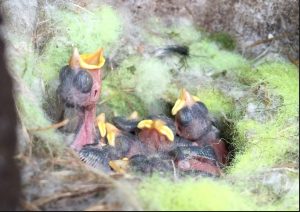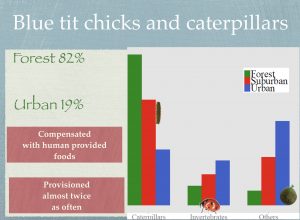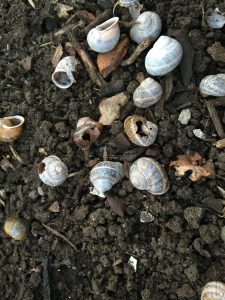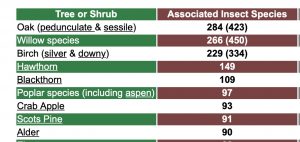Birds diet and calcium
Let’s start at the beginning, nestlings are ‘wrapped’ inside the hard eggshell. Calcium is an essential element in the diet of birds, particularly when they are producing eggs which need calcium to be viable. Insects are low in calcium and in winter months insects are less available anyway so b=birds could not store up an accumulation. Birds that eat insects or seeds usually depend on a calcium-rich food source to supplement that deficiency. Our garden songbird bird families do not ‘store’ the extra calcium needed for egg-laying in advance in their skeletons. They have to eat it and eat it daily, whilst egg-laying. Without it, many birds can produce defective eggs and have a higher rate of hatching failure. Besides matching the breeding cycle with maximum food availability, temperature and day length, females have to have enough calcium in their gut to actually lay an egg. Female Blue Tits, for example, are known to stop their normal food feeding bouts in time for them to find a calcium resource, just prior to roosting. In effect a calcium feeding bout.

Blue Tit chicks begging for food. We want food! NOW!
Calcium and skeletons
Stenning states that a female Blue Tit weighs about 10 grams, with one egg weighing about 1 gram. Perrin shows that the eggshell weighs about 0.1 gram and is mainly composed of calcium carbonate with about half of that being calcium. Her whole skeleton itself only weighs about 0.6 grams, there is simply little calcium stored to produce eggs. Unlike chickens which store some of the calcium required in their own skeleton. He goes on to say that roughly speaking they must eat enough each day to form the eggshell.
The importance of calcium
If you live in an acidic area, it is likely that snails will be less abundant and birds need longer to find calcium, depriving them of food searching and feeding time. In fact, Great Tits were noted to break away from feeding to double their calcium searching time when none was readily available for them, even burrowing in the soil to eat sand and small stones. All very time-consuming. Less time feeding can result in birds not receiving their full quota of nutrients required for daily living. This, in turn, can result in birds laying fewer eggs, smaller eggs, or just having one brood instead two or more. Calcium is also required for other larger birds as some of it may be taken from the skeleton when laying eggs and it would need to be replaced. Young birds growing rapidly need calcium as its availability affects bone growth.
Calcium sources
Calcium, like other elements, can be leached from the soil by rain and particularly acid rain. Where do they find the large amounts required for egg production? Grit, eggshells, calcium-rich sand, lime-rich mortar and possibly the bones of dead small mammals and bones found in owl pellets. But who has such calcium-rich sources in their gardens? Some bird food retailers add oyster shell grit to their bird foods to assist birds, at breeding time. There are records of song thrush or blackbird eggshells, and small snail shells found in Blue Tits nests. Birds are also known to eat their own shells when the young have hatched. Waste not, want not! Although Stenning states that Blue Tits eat small snails, I doubt that they would find sufficient numbers to convert to form their eggshells and it would simply be too uneconomic in terms to energy use and time spent searching.
Different species find different sources
Robins, wrens and pied flycatchers will forage on the ground to obtain their calcium requirements by eating woodlice and millipedes, both abundant dwellers in compost and mulches, with 3 times the amount of calcium than snail shells. If you have many millipedes and woodlice in your garden it may well indicate a calcium-rich soil although they require less calcium than snails. Robins and wren are ground foragers and are well able to cope with finding such invertebrates. Whereas Blue Tits and Great Tits are mainly tree canopy feeders and in general do not forage often on the ground, although Great Tits will forage for beech mast from autumn onwards and for as long as they are available.
By having more tasty morsels for them to eat on the ground, particularly millipedes and woodlice, which like to eat decaying organic matter, as found in an organic mulch or garden compost, they may well serve as additional calcium sources for them or other small insectivorous birds if they do venture on the ground which they must do to search for snails shells. Young blackbirds are unable to get enough calcium for their growth from earthworms alone. But can from the soil found in the earthworms guts! Compost and compost mulches attract worms in abundance. Thus nutrient-rich vermicompost may well provide enough worms and subsequently earthworm gut-soil for young blackbirds to thrive.
Utilising snail shells for bird’s eggs
Perrin states that Blue Tits have been found to eat snail shells just before they go to roost overnight, something I have observed many times now. Once inside a female Blue Tit’s gizzard, once she goes to roost the calcium in snail shells would be utilised about 36 hours later for an egg to be laid. If she consumed it any earlier in the day, it would leave the gut by the time it was needed for eggshell formation. She only has a narrow timeframe and timing their calcium intake greatly affects the bird’s ability to collect enough calcium for eggshell formation. Lack of calcium is probably the most limiting macronutrient required by laying birds. There are reports of poorly developed young tits in pine woods possibly due to the fact that such woodlands are in general acidic where snails are rare and the parents may not be able to find enough calcium for their young to develop normally.
Feeding their nestlings
Quantity of food is much easier to measure, especially today with nest box cameras than the quality of food. Quality of food is important. Like our own young babies, they have different nutritional requirements from different foods at different stages of their young lives. Adequate nutrition through infancy to early childhood life is necessary to help the child grow healthily and develop into a healthy toddler and beyond.
The same can be said for Blue Tits and other wildlife for that matter. Kathryn et al, states that early nutrition shapes life history, parents, therefore should provide a diet that will optimise the nutrient intake of their offspring. For Blue and Great Tits this will consist of fresh caterpillars, bearing in mind, the British Trust for Ornithology (BTO) state that each chick can eat 100 caterpillars a day! So a brood of ten requires 1000 a day! Perrin states that these birds may bring caterpillars to the nest at the rate of almost one a minute during much of a 16-hour day! If one parent dies the number of caterpillars required may simply be too much work for one parent alone, which can have serious consequences for the nestlings, some of which may die.
It is well documented that Blue Tit and Great Tits adults time their egg-laying and incubation to the bud burst emergence of oak tree leaves, although recent work by BTO researchers has found that climate change can affect this timing and have described it as a phenological mismatch. Oak trees can have a huge population of winter moth caterpillars which use oak leaves as their preferred food plant choice. There are about two hundred species of moth caterpillars munching away, on the fresh green tannin-less oak leaves and Perrin states that an exceptionally large tree may carry half a million caterpillars! Winter moth caterpillars are capable of causing serious defoliation of oak trees in Britain. To combat this the oak tree is able to produce a second flush of leaves known as Lammas growth which led to the Lammas Day holiday, sadly not now commemorated by many people in our modern-day. Blue Tits and Great Tits to the rescue of oak leaves! Although Perrin states that erecting nest boxes for tits as a way to control the caterpillars is doubtful. This bonanza of caterpillars will be exploited by both Blue and Great Tits to feed their nestlings with the caterpillars they find on oak trees when they hit ‘peak caterpillar’ numbers. Although territorial these birds will travel some distance to collect them.
Choicest caterpillars offer the best chance of chick survival
As the weather warms up caterpillars eat and eat and grow and grow. They have to be quick because the oak tree does not want its leaves to be eaten at this early stage of its growth. It is a race between the oak tree and the caterpillars. The oak leaves during their early growth provide maximum leaf protein and minimum leaf sugar. for the caterpillars. These leaves are thin, soft, fresh and fragile, therefore easily torn and eaten by caterpillars. Perrin showed how early breeding tits were at a considerable advantage over later breeding tits, as it was more likely they had young that survived and subsequently enter the breeding population. In other words, these birds had the choicest caterpillars which were feasting upon the choicest leaves. Interestingly Stenning states that as female winter moth cannot fly, it is likely that a particular natal oak tree will support the same winter moth gene line for a very long time.
Oak leaves change their chemical composition
The oak tree draws upon its defence strategy using fancy chemistry! It makes its leaves unpalatable. As they age the chemical composition of the leaves changes to oak tannins which inhibit the growth of the winter moth caterpillars and makes the leaves tougher to chew and harder to digest for winter moth caterpillars. Other species of caterpillar are capable of feeding upon older oak leaves. Winter moth caterpillars which feast upon the earliest of leaves receive the best diet, grow faster, become larger and survive better than those that emerge later. Hence the peak caterpillar numbers.
Tannins affect caterpillars and nestlings
Perrin found that when given an oak tannin supplement via mealworms, nestlings grew less well than those that were not. When caterpillars are predated upon, they have shredded leaves in their gut. An excess of tannins in the gut of the caterpillar impedes the food resource for caterpillars to utilise thereby reducing the quality of the food for the birds, which affects the growth of the nestlings which consume them.
Perrin describes how Great Tits sometimes removes the head and gut of larger caterpillars. Stenning, suggests that this may be to reduce the amount of tannin in the gut? A very long internet search I found that Great Tits do indeed remove the gut from caterpillars so that tannins will not retard the chick’s growth.
Large caterpillars may kill a young chick
Perrin states that a large caterpillar can inflict a serious bite on a young tit and if they manage to grab hold of the inside throat of a chick, the bird may choke and die. I have seen adults hold the prey item, ‘hold-hammering‘ holding it underfoot and pecking at the head of the caterpillar and/or beat it hard against the twig it is resting on.
Just like adult Blue Tits kill larger caterpillars for their nestlings, this adult wren did the same though for itself
Stenning describes what happens if there is enough food they will carefully and selectively feed the smallest nestling. If there are not enough caterpillars to feed the nestlings, they may starve beg frantically, with large gaping bills and loud calls. The food item is put into the first open gaping bill the adult encounters and will then quickly leave the nest to find more food. This way the strongest and nestlings survive with the weakest smallest dying of starvation thereby reducing the brood. When caterpillars are in short supply adults resort to sub-optimal food, such as aphids or peanuts pieces to feed their nestlings which can be disastrous they have been known to choke on peanut pieces.
Urban and rural Blue Tits
Stenning states that gardens and streets tend to sub-optimal habitats having a low capacity to provide to sufficiently provide the nestling with the nutritional requirements as obtained when fed with arboreal green caterpillars they need to develop and survive.
Other prey items
Perrin states that besides caterpillars, Blue Tits also feed nestlings with greenfly which they feed by gathering a whole beakful at any one time, as these prey items are small they bring many of them but if larger prey they bring just one prey item, thereby maximising their feeding of the nestlings. Pollock et al in their detailed analysis of Blue Tit food items, found that Blue Tits breeding in forests fared better than those breeding in urban/suburban areas, due to a significant reduction in caterpillar numbers due to low tree density, especially oaks, forcing their urban cousins to find caterpillar alternatives (non-optimal) resulting in them having to provide each nestling almost twice as often. That’s a lot of work! They found the urban parents appeared to provision more ladybirds and spiders, ( even though there were fewer invertebrates there than the rural site) along with multi-seed mixes, fat balls, peanuts and sunflower seeds from bird feeders.

From Pollock et al “Integrated behavioural and stable isotope data reveal altered diet linked to low breeding success in urban-dwelling blue tits (Cyanistes caeruleus)”. Even though many people will suspect there is a lack of caterpillars in urban areas its nice to know that these researchers confirmed this.
Feeding spiders
Although the feeding of spiders to nestlings are often observed in a number of passerines, and Stenning states that the essential nutrients needed for healthy growth that is possible for only spiders to provide, the exact reasons for this change of diet from caterpillars to spiders were unknown until fairly recently. Perrin states that the birds are now being selective in such a way that it suggests it is they are selecting quality rather than its availability. he continues that they make up less than 5% of the diet but this increases when the young are about 5-8 days old and may constitute up to 10% of the diet. It’s such an obvious change in prey items for the Blue Tit chicks that the adults had deemed it necessary to change the diet because there must be something in spiders that the adults become aware of that nestlings require as part of their development. How do they know this, at what time in their development and for how long is this requirement necessary to feed their chicks with spiders? What is the trigger for this change in diet? Is it the caterpillar size, sheer instinct or both? At that time the reasons why were unknown to scientists. Until now.
Why the increase in feeding spiders?
Spiders are rich in taurine an amino acid. Garcia-Nava states it is essential for the proper development of the visual systems in both birds and mammals. Fed to them just about at the time that nestlings are opening their eyes when they will have to compete with the others for food. Kathryn et al found that birds fed upon taurine were more successful spatial learning, they showed intermediate levels of risk-taking. Spiders contain 40-100 times more taurine than caterpillars. When to feed them spiders could be triggered when the parents see the eyes of the nestlings are beginning to open when they are about 5 days old. When this happens birds will become more aware of their surroundings and start moving around the nest more, becoming aware of their the other nestlings in the nest. Let the battle for food begin!
The nest as a battleground
Researchers at NERC describe the inside of a nest as being a battleground. Parents are in conflict with each other over workloads, nestlings are in conflict with their parents and each other over the food distribution. Having eyesight earlier than for example, the late hatching ‘runt’, allows them to see the food, then beg and reach higher to grab it. However the runts have a trick up their sleeve and according to Mainwaring et al, they grow longer legs to be able to compete with their core siblings, though may pay the price later in life by having shorter wings, (resources used to grow bigger legs instead) and therefore may not be as manoeuvrable when evading a predator.
Spiders have a high calcium content
Alternatively, Garcia-Nava states another reason given could be that as spiders have more calcium than caterpillars, being fed at this stage may increase the nestling’s bone structure.
For those of you who would rather a less technical article about Blue Tits and spiders try this one ‘Super Spiders Make Bolder Birds’
What can we do to help?
1) Collect empty snail shells!
I find many snail shells in the winter when the weather has killed them. I used to crush them along with chicken eggshells and mix the lot up with birdseed placed on a ground feeder tray. I don’t do this now, as it is difficult to see exactly if the birds take the added calcium and if they did was it the crushed snail shells of the crushed eggshells? Would they recognise crushed eggshells and crushed snail snails amongst the seeds? I have developed a much better method that works. I have found that when placing whole snail shells together, then push the shell into the soil, hole first, which embeds and stabilises it. It makes it much easier for the female Blue Tit to land on the shell and peck the quantity she requires from the complete shell. I have observed several over the years do this, often accompanied by the male who escorts her to the shells and waits nearby whilst she pecks away. She will in most cases, retire to the nest box almost immediately with the male hanging around a little longer, occasionally ‘singing’ before he himself retires. This method has proved by far the best method. Although they may well eat the crushed eggs shells I place nearby, I have not observed this, it has only ever been the snail shells. Perhaps given the choice they readily recognise the snail shells and do not recognise the crushed chicken eggs shell? If a bird pecks away at a snail shell, fragments will fall onto the soil and she will recognise these as part of her work and eat them, as opposed to my crushed snail shells which may not be so easily recognisable? If you don’t embed the snail shells into the soil, the birds have to balance on the upturned entrance hole (aperture) which can wobble making it difficult for her. I have seen Blue Tits and Great Tits, wood pigeons, collared doves, robins and blackbirds in my garden eating snails shells/crushed eggshell/seed mixture, though it was hard to tell what bird was eating what. I now have a spot I use every year on a raised bed to observe them more closely.

Collect snail shells for female Blue Tits
Plant oak trees!
Ok, its highly unlikely that most of you do not have the garden space to plant a native oak tree.

Trees and shrubs to plant to help wildlife exert
For a full list click here
A useful and informative article can be found here Alexander, A., Butler, J. and Green, T. (2006) British Wildlife 18(1): 18 – 28.
Leaves areas rough in your garden to encourage spiders
BTO Garden BirdWatch
If you like watching birds in your garden, do consider joining the BTO Garden BirdWatch you can receive advice and learn so much more about your garden visitors.
Refs.
Besides my own experiences, observations and links above-
Bures, S & Weidinger K (2003) “Sources and timing of calcium intake during reproduction in flycatchers” Oecologia
Graveland, J & Wal.R, (1996), “ Decline in snail abundance due to soil acidification causes eggshell defects in forest passerines”, OECOLOGIA Volume 105, Number 3, 351-360, DOI: 10.1007/BF00328738
Graveland J, Berends AE. (1997), “ Timing of the calcium intake and effect of calcium deficiency on behaviour and egg-laying in captive great tits, Parus major.” Physiol Zool. 1997 Jan-Feb;70(1):74-84.
Graveland, J & Drent, RH (1997) “Calcium availability limits breeding success of passerines on poor soils” Journal of Animal Ecology 66, 279-288, British Ecological Society
Kennedy, C.E.J. and Southwood, T.R.E. (1984) The number of species of insects associated with British trees: a re-analysis. J. Animal Ecology 53: 455 -478
Mand, R, Tilgar V & Leivits A, “Calcium, snails and birds: a case study” Web Ecology 1 pp 63-69 (2000) OECOLOGIA 1996 Volume 105, Number 3, 351-360, DOI: 10.1007/BF00328738
Perrins. C (1979), “British Tits” The New Naturalist, Collins, London
Reynolds. S J . Perrins C M. “Dietary calcium availability and reproduction in birds” Current Ornithology, 2010, Volume 71, p 31-74.
Stenning M, (2018), “The Blue Tit’ T & AD Poyser London

Recent Comments